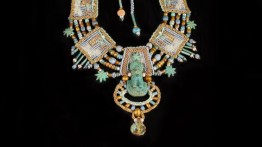COOPERMADE: Wearable Art History

Making jewelry wasn’t Barbara Natoli Witt’s ambition when she graduated from Cooper in 1958, having studied graphic design. "I wanted to do printing, but in those days you couldn't get into the Printers Union as a woman,” said Witt in a 2006 interview, “so I started fooling around with fiber and really liked it." Those experiments with fiber eventually led to using various knotting techniques for rug and tapestry weaving, and Witt began applying those skills to beaded jewelry, building a scaffold of hand-dyed nylon to fashion intricate woven patterns. Today, Witt is renowned for richly colored beaded necklaces favored by Diana Vreeland and Marella Agnelli, among others.
Witt’s designs often revolve around an exceptional artifact or precious stone. Clare Booth Luce, a writer married to the founder of Time Inc., once asked her to design a necklace that would showcase a golden dragon given to her family by Chiang Kai-Shek. However, a survey of Witt's work is far more than an exercise in learning the tastes of celebrity: to study her necklaces is to engage in the history of a vast array of styles spanning eras and continents. She has collected extraordinary antique beads—a Greek bronze horse (500 BCE), a Kilia marble head from Anatolia (ca 2500 BCE), an Egyptian scarab (700 BCE), and an Olmec obsidian head (ca 1000 BCE), among many others.
While she’s also just as likely to deploy plastic elements or simple objects that fit her bigger aesthetic vision, the elements of Witt's pieces are only the physical manifestation of her work. Behind it all, she constantly researches the visual culture of the civilizations from which she draws inspiration, noting cross-cultural parallels, and the universal interest in adornment.
Her jewelry can be found in numerous collections including the Cooper-Hewitt, the Smithsonian, and the Museum of Arts and Design.





